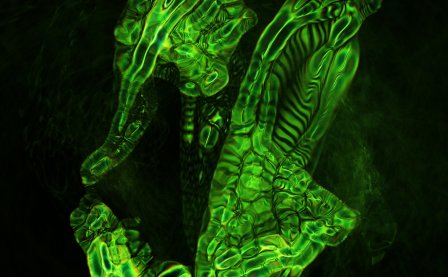It’s been just over a month since the release of Burial’s latest on Hyperdub and the inevitable critical shitstorm it kicked up on the web. Superlatives heaped on superlatives. Everyone did their best to drop as many references as possible to hauntology, psycho-geography, rave-nostalgia, and rainy nights in London. And all the while, as the blogosphere went into critical meltdown, it became increasingly clear that hardly anyone actually cared what made this record interesting or different at all. Burial-the-Artist was what really got peoples’ juices flowing, and the Kindred EP was simply a convenient excuse for a gigantic, collective jack-off session. The Quietus even ran a not-entirely-tongue-in-cheek competition on its Facebook page as to which review was the “wankiest.” (Pitchfork took the title.)
But the Kindred EP is different, and it does constitute a development in Burial’s sound. It’s also certainly worthy of the hype, but the reason why isn’t of the kind you’d expect. That is, there’s nothing especially different about the sonic language on offer here: the EP still sounds like Burial. Sure, there are some new samples — the ‘bellowing thunderstorm’ at the start of the title track — the beats being used/’referenced’ tend to sink a little further back in the mix; and occasionally — shock horror! — a vocal is left almost entirely untreated. There’s also an intriguing moment at the start of “Ashtray Wasp” where (for the first time?) Burial seems to refer to himself in addition to the rave tradition, redeploying a figure that originally appeared on Untrue’s “Endorphin”: echoes of echoes of misheard echoes. But all these differences feel small, incremental, modest somehow. The real progression on the Kindred EP relates to Burial’s use of musical time and space.
The length of the tracks on Kindred is something that most reviewers have picked up on, if only in passing. Where the majority on Untrue clocked in at somewhere between three and five minutes, with the longest being the title track at 6:16, Kindred’s three tracks, by contrast, come in at 11:26, 7:28, and 11:44, respectively. Now, obviously bigger does not necessarily equal better; frequently the opposite, in fact. But the cuts on Kindred aren’t simply longer than before; they introduce a completely different sense of space and continuity. This is the point that, in their eagerness, everyone seems to have missed. But this is why Kindred is so strong.
Take the title track, for instance, the first on the record. It begins with the distant rumble of a storm and a voice peaking out through the fuzz and the rain. It’s nearly a minute before the beat scuttles in, and when it does, it feels like an intervention, an interruption of the urban peace. A couple of minutes later, though, it just falls away entirely. The wind blows. A fractured voice returns bookended by cracked and bristling ‘silence,’ and the beat skips back on in again, more or less the same as before. At around 6:30, it begins to decompose again. A break in the beat becomes a long interlude. Voices. Nothingness. Space. Fragments. And then that same familiar pulse returns, except now with a brighter mood. A high synth. Hope, maybe. And then no synth at all, the beat naked. Another cracked silence. Clouds rumbling. Finally, a totally new theme emerges over an entirely new rhythm, fainter this time, more distant. And it doesn’t last long, barely a minute. Fading now. Quiet. Calm. The sound of the needle lifting? And it’s over.
There’s a sense of continuity here, of thematic variation, interruption, narrative, scale, that was only ever latent in Burial’s previous work. When it was there, it operated at the level of the album as a whole rather than at the level of individual tracks. By opening up the length of those tracks on Kindred, in other words, paradoxical as it might sound, Burial actually gives himself the time and space to focus. There’s something really self-conscious about it, something sculpted. It’s as if we’re being asked to listen a certain way, to consider each track as an independent ‘work.’ Not that Burial’s listeners were ever exactly reluctant in that respect, but the invitation this time seems far more overt.
We could almost reverse our original observation in relation to length then. It’s not so much that Burial is saying ‘look how long I can make these tracks last, look how much I can fit into them.’ What he’s really saying is ‘look how successfully I can distill the dynamics of an entire album into so little space.’ If you don’t know what I’m getting at, listen to “Ashtray Wasp” again. This is where the logic is at its most obvious. It’s a symphony of a track, a whole world of sound in 11 minutes, 44 seconds. And when that cascading theme finally emerges after all the noisy interventions, reprises, and about turns… what’s the hauntological for Bliss?
(with thanks to Nick Croggon and Peter Chambers for the Burial-related chats)
More about: Burial




